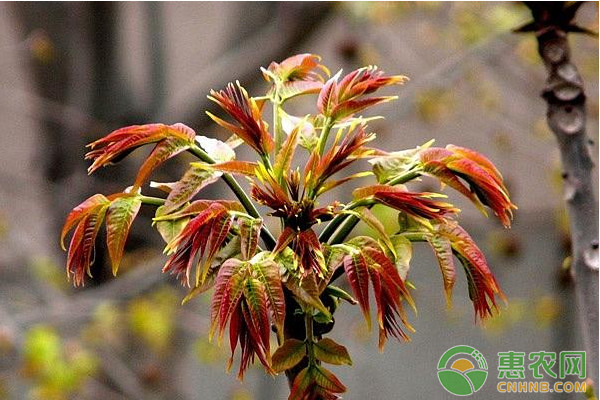It’s going to be winter soon. Recently, many farmers who want to plant camphor are asking Xiaobian, how to cultivate the camphor in winter, and the following series of Huinong.com will introduce you to a pollution-free winter cultivation technique!

1. Variety selection: In winter production, the varieties of camphor buds should be bright, shiny, rich in flavor, strong in growth, good in disease resistance and cold resistance, and more used in production.
2. Germination and sowing: Toona seed is oval, flat, reddish-brown, 5 to 7 mm long, with membranous wings at the upper end. Before germination, the membranous wing is rubbed off by hand, and then soaked in warm water with a new high-fat film for 4 to 5 hours, and the seed is wrapped in cotton and placed in an environment of about 25 ° C to germination. During the germination process, the seeds are washed once a day with warm water of 25~30 °C to remove harmful substances secreted by the seeds. When 30 to 40% of the seeds are exposed, they can be sown. The sowing depth is 1~1.5cm. The soil should not be too thick. After sowing, cover it with film or straw to moisturize. It can be emerged in about 7 days. The seed is 1~1.5 kg per mu, and the sowing time is mid-April.

3. Seedling management: After emergence and time seedlings, the seedlings can be divided into two times, the first time when the true leaves begin to vomit, the second time in 2 to 3 true leaves, the seedlings, about 10,000 seedlings per acre . Xiangxi Miaoxi is afraid of phlegm and phlegm. In the early stage, it is necessary to strengthen the management of fertilizer and water, and promote the rapid growth of seedlings. When the seedlings grow to 1.2 meters in July, the height of the control seedlings of Huawang No. 3 is sprayed. After August, the fertilizer and water seedlings are controlled to promote the seedlings. top.
4. Seedlings and planting: In the middle and late October, the leaves are seedlings, and the ditch is 80-100 cm wide and 1~1.5 m deep. The camphor seedlings are placed obliquely in the ditch, some soil is buried in the roots, and some are poured. Water, covering the shade, promoting plant leaves and dormancy. After 10~15 days, all the leaves can be moved to the greenhouse for planting. The greenhouse is made up to 1 meter wide in the north-south direction. When planting the seedlings, the things are made in rows and plants. The planting is about 40,000 plants in the south, and the short seedlings are planted in the south, and the high seedlings are planted in the north. Watering after planting. The temperature in the shed is controlled at 20 to 25 ° C during the day and above 10 ° C at night.
5. Shooting: When the camphor bud grows to 15~20 cm, it can be picked. After picking, the new high-fat film is sprayed on the surface of the camphor bud and placed in a food bag for preservation.
Regarding the cultivation technology of the camphor in winter, the small series of Huinong.com will introduce this to you briefly today. Friends who need it can refer to it!
We are manufacturer of Outdoor PTZ Camera in China, if you want to buy Mini Camera , Outdoor Camera,Hidden Wireless Cameras,Camera Cctv With Motion Detection Solar Camera please contact us.
What is solar monitoring?
Solar safety camera, also known as solar panel safety monitoring, uses solar energy to supply power for compatible monitoring.How does the solar surveillance camera work?
Solar powered surveillance cameras use solar panels to harness sunlight and convert it into direct current (DC). The inverter then converts direct current to alternating current (AC), which can then be used to power the solar monitoring.
What happens when it rains or it's cloudy -- can solar surveillance cameras work?
Most solar cameras are also equipped with alternative or backup power supplies, usually rechargeable batteries. The solar panel not only powers the Security Camera, but also charges the battery. When there is no direct sunlight (i.e. at night or in rainy days), the solar powered security camera will be powered by rechargeable batteries. Once there is direct sunlight, the battery will start to charge.
Benefits of Solar Monitoring Cameras
The main advantage of the solar monitoring camera is that the solar panel charges the battery powered camera, creating a renewable power supply. Although a Wi Fi connection is required, these cameras can be used in areas of the home that are difficult to access, such as roofs. For places that are not suitable for using wired security systems, the solar safety monitoring camera provides a reliable choice of security systems without the trouble and additional costs of running cables.
Wireless Solutions
Internal battery charging
Easy to install, no installation cost
Easy to track private property
Scalable solution that can be easily adjusted to meet your future needs - as many solar panels can be added as possible as the camera power
Environmentally friendly
Outdoor PTZ Camera,Outdoor Camera CCTV HD Security,Full color HD 1080P AI Camera, PTZ Camera Outdoor Network wifi,1080p Night Vision camera
Shenzhen Fuvision Electronics Co., Ltd. , https://www.outdoorsolarcameras.com